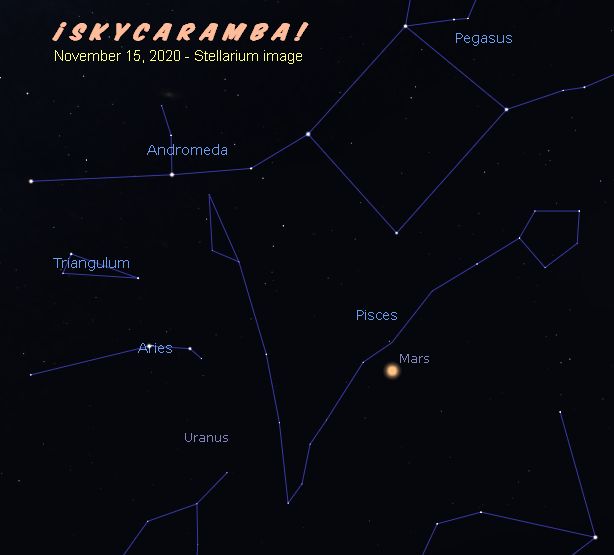As the sun sets at the start of November, Boötes and the orange star Arcturus are setting along with Ophiuchus and Serpens. Jupiter and Saturn are in the south as they draw closer together for their great conjunction in December. Mars is rising alongside Pisces. Orion and Gemini are late evening risers. Venus and Mercury are morning objects.

As the month goes on, Jupiter and Saturn are moving eastward with Jupiter catching up to Saturn. The moon will pass by them on the 18th and 19th. Mars is first moving slowly westward and then turns around about mid-month. The moon passes it on the 25th. Venus and Mercury are the most mobile planets. They start in opposite ends of Virgo. See Venus close to Porrima on the 5th. On the 10th, the two planets make a stretched triangle with the bright star Spica. That’s the day Mercury is at greatest elongation at 19.1° west of the sun before it turns around and goes sunward again. A thin crescent moon passes through the neighborhood on the 12th and 13th. Mercury moves sunward so fast, it’s hard to see during the last week of the month when it’s in Libra. Venus is going after it in hot pursuit.

The Leonid meteor shower’s forecast peak is on the 17th. Best viewing is in the morning when Leo is up. This year’s shower isn’t expected to be spectacular, but observers in the Americas may get the best of the peak at up to 15 meteors per hour.

The waning gibbous moon is at northern lunistice 24.8° north of the equator on the 5th. It’s at last quarter on the 8th. It goes south of the equator on the 12th, is new on the 15th, reaches 24.9° south of the equator on the 18th, first quarter on the 22nd, and goes north of the equator again on the 25th.

The full moon on November 30th comes with a penumbral eclipse. It’ll be visible—as penumbral eclipses go—from northeast Asia, most of the Pacific, and North America. It’ll be a moonrise event for Australia and most of the rest of Asia. And it’s a moonset event for South America and the northern Atlantic. For four hours, 21 minutes starting at 7:32 Universal Time, the moon will pass through the outer part of Earth’s shadow. It’ll be deepest in at 9:44 and emerge from the shadow at 11:53. Penumbral eclipses don’t produce the deep darkening of any part of the moon like we have in partial and total eclipses. If you could be on the moon when it happens, you’d see the earth blocking part of the sun. Since a lot of sunlight is still reaching the moon, earth based viewers who don’t know an eclipse is happening might not notice anything. If you look carefully, you might see that one side of the moon looks a little less brightly lit than the other. It may even look a little more tan or yellow because of sunlight going through Earth’s atmosphere first. These effects can be very subtle and will be most noticeable around the middle of the eclipse.
The moon will be closest to Earth on the 14th at 357,800 km center-to-center and farthest on the 27th at 405,900 km.
Mercury is at perihelion on the 2nd at 0.307 astronomical units (earth-sun distances) from the sun.
Some notable conjunctions this month:
1st Mercury and Spica 4.0°
3rd Moon and Aldebaran 4.5°
6th Moon and Pollux 3.8°
9th Moon and Regulus 4.4°
12th Jupiter and Pluto 0.7°
12th Venus and moon 1.6°
13th Mercury and moon 1.6°
16th Venus and Spica 3.8°
19th Jupiter and moon 2.5°
19th Saturn and moon 2.8°
23rd Neptune and moon 4.1°
25th Mars and moon 4.5°
27th Uranus and moon 3.1°
30th Moon and Aldebaran 4.5°

A comet to watch if you have a telescope is C/2020 M3 Atlas. This object discovered in July has brightened up a lot more than expected. By mid October, it was around magnitude 9, visible in small to mid-size telescopes in dark skies. After its perihelion on October 26, it will travel northward along Orion’s western side in November. How bright a comet will be is notoriously hard to predict. It may get much brighter or it may go dimmer. All I can tell you as I record this is to try your luck.
